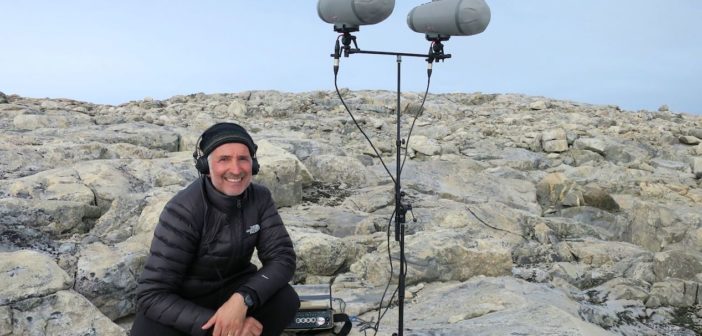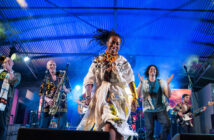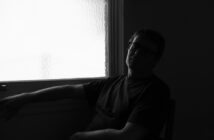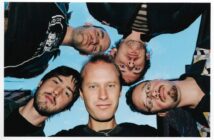Philip Samartzis is a Melbourne based field recordist, composer, experimental artist and educator. He is best known for crafting incredibly dynamic and expressive environmental sound pieces developed with highly detailed field recordings that are then juxtaposed, manipulated and altered – though his oeuvre also extends into experimental improvised new music ensembles, turntable manipulations, and microtonal synth work. He has published numerous solo recordings including Residue (1998), Windmills Bordered by Nothingness (1999), Mort aux Vaches (2003), Soft and Loud (2004) and Unheard Spaces (2006), and has been awarded an Australian Antarctic Division Arts Fellowship on three occasions in order to document the effect of extreme climate and weather events on the human condition. His latest works are collaborations with percussionist Eugene Ughetti, Array (Room40), which features recordings of radar and scientific instrumentation used for upper atmospheric research and terrestrial communication, and Polar Force (Room40) which is a live performance utilising Samartzis’ polar recordings. They’re both unique and fascinating works in their own right. He truly has a unique relationship with sound as you will see in this Cyclic Selects that he was kind enough to do for us.
From Philip:
In 1973 I bought a battery-operated tape recorder with an inbuilt medium / shortwave radio for my tenth birthday. I recall the first recording I made was Billy Joel’s Piano Man broadcast on 3XY. I particularly enjoyed forwarding and rewinding the song as I experimented with the transport system. After a few hours the recording gradually played back slower and slower as the four type-D batteries lost their charge. At the time I didn’t really understand what was happening, but I did like the way the Piano Man sounded “makin’ love to his tonic and gin”. I eventually started to explore the shortwave function – listening in to various bursts of electro-static discharge, ghostly voices, and weird electronic pulsations before discovering the BBC world service. Something about the sound of Big Ben chiming over time and space sent a chill down my spine. In 1977 I happened upon 2JJ on the shortwave band which was quite the revelation. While daytime programming was filled with rock and punk, night-time offered more expansive material. It is on this spectral frequency band that I first heard tracks from Chrome’s Alien Soundtracks LP which looks and sounds as good today as it did back then. I immediately fell in love with Damon Edge’s propulsive drumming and the sound of Helios Creed’s caustic guitar. The use of cheap electronics, television samples, tape manipulation, and tight, weirdly arranged compositions provided a nice tonic to the leaden, abject music emerging from the UK at the time. Hearing Slip it to the Android on fuzzy shortwave radio offered a glimpse into a parallel universe that I desperately sought. I haven’t heard a Chrome song since that I haven’t liked.
I went to Newlands High in Coburg which was located right next door to Pentridge Prison before both were converted into housing estates. One of the benefits of the school’s location was that we were sent home under police guard each time there was an escape as a precaution against kidnapping. My Form 5 English teacher occasionally took our class to Pentridge to attend plays organised by the prisoners. During our trips we would tour the cells and chat to prisoners about life on the inside. George Phillips was one of my classmates who shared a love of experimental music. One day he arrived to school with Negativeland (1980) which he bought directly from the band through mail order. I didn’t really like the LP all that much, but it did lead me to Negativeland by Neu! which was much more interesting for its combination of jarring jackhammer, cool rhythmic pulse and searing guitar wash – all underpinned by sudden shifts in tempo. Of the three Neu! LPs Neu! 2 (1973) held a particular fascination for me for its use of pitch and speed manipulation that make up most of side two. These experiments signified that record and tape players could be used as legitimate musical instruments for sound generation and manipulation above their usual function of sound playback. I also appreciated the radical gesture of placing such abrasive experimentation against some of the most beautiful music Klaus Dinger and Michael Rother ever created. In 1991 I found copies of La Düsseldorf’s first two albums La Düsseldorf (1976) and Viva (1978) at Bleeker Bob’s Records in Greenwich Village and have not stopped listening to them since. Klaus Dinger’s expansion of the Neu! sound into a richly textured distillation of anthemic rock still has me punching the air in euphoria. In 2010 I travelled to Antarctica by icebreaker to record the sounds of life on a remote ice station. Neu! provided the steady pulse while travelling the Southern Ocean, and La Düsseldorf kept me company during field work in bitterly cold conditions. Towards the end of my trip auroras magically appeared to light up the night sky. I made a habit of watching the billowing folds of light and colour by laying on the ice and listening to Cha Cha 2000. I felt some comfort sharing the moment with Klaus who I am sure enjoyed the light show as much as I did.
Between 1982 and 1984 I worked at Fitzroy Post Office as a postal clerk and telegram operator with the intent of saving money to travel overseas. I commuted to work on a red Kawasaki 250cc motorbike usually gripping my well-thumbed copy of Wild Boys by William Burroughs and dreaming of the Yucatan. My colleague Frank was a large balding man who would regale me with memories of his membership of the Hitler Youth. “Those were the days” would conclude many of the observations he offered on the upside of National Socialism. Our conversations were regularly interrupted by Orange People collecting battered parcels of beaded wooden necklaces from India. For a purported sex cult, the anglo-saxon variety of Rajneeshee seemed awfully emaciated and unkempt. After saving enough money I undertook a hitchhiking tour of Mexico before eventually arriving in London where I picked up NON’s Pagan Muzak at Rough Trade. The release comprises 17 tracks of locked grooves and includes an off-centre hole drilled for an alternate method of play. I carried that record with me for a long time. NON performed in London soon afterwards supporting Einstürzende Neubauten at the University of London. On a bare stage stood a small black box on top of a lone mic stand, and next to it a long wooden box placed on the floor. After a while NON appeared dressed in black similar to a SS storm trooper. He stood by the small box for a short while staring intently into the crowd before raising his hand to switch it on. It is hard to describe what happened next other than to say that the noise emitted from the box was well beyond the pain threshold – whipping the anaemic crowd into a frenzy. After about 15 minutes of aural torture the box is switched off. NON then proceeds to take his shirt off while some roadies lift the lid off the wooden box revealing a bed of nails. NON then carefully lays down while one of the roadies places a large concrete slab on his chest. Another roadie then appears with a sledgehammer, and begins to pound the concrete, all of which is amplified. After about ten-minutes of pounding the concrete is smashed to bits. NON then rises from the bed of nails, dusts himself off and stridently exits the stage.
In 1986 I came across an add at LEEDIN – a record shop on Smith Street, Collingwood – by Andrew Curtis looking for people with similar music tastes to form a band. One of the names on the list was Zoviet France so I gave him a call. Zoviet France provided the blueprint for what we would pursue together as Gum although our methodology was somewhat different. The Zoviet France album that we were both drawn to was Mohnomische – an epic double LP from 1983 with a cover made of thick sheets of Masonite. I bought mine from Pipe Music which often involved declining an invitation to listen to the latest Jane and Scorpion LPs imported from Germany. Andrew and I used to drive around Melbourne’s docklands late at night playing Mohnomische at high volume while Andrew took medium format photos of grain silos and sub stations. Mohnomische is a mesmerising listen comprising long drawn-out drone scapes, weird electronic shards, and echoing phrases. Its raw and beautiful – harsh and dreamy. We studied the record with great intent and reproduced some of its timbral and rhythmic qualities on our first LP Vinyl (1987) using prepared records and repurposed turntables. Philip Brophy engineered our recording sessions on a Tascam 388 8-channel reel to reel porta-studio and got some great results from often very crude source material. We continued on for a few years releasing another LP and a couple of singles using similar methods. We decided to conclude our turntable experiments after receiving far too many fan letters with National Socialist leanings. Our pastiche of industrial music and its penchant for lugubrious iconography seemed to have been taken a little too seriously in far flung places, placing Gum into an existential crisis. A cautionary tale of flying a little too close to the flame. Some years later I performed a solo set at an experimental music festival in Amsterdam. I was mistakenly introduced as Philip Samartzis from Zoviet France which I was delighted with.
In 1986 I commenced a BA in Media Arts at Phillip Institute of Technology in Bundoora – at that time the very edge of metropolitan Melbourne. I was offered a place based on a video folio I produced inspired by Monte Cazazza’s Mary Bell (1980) – a child killer from Newcastle-Upon-Tyne. The place from which Zoviet France hail. Philip Brophy was the Sound lecturer and introduced my class to some amazing music that I was only vaguely aware of. The composition that had the most profound effect on me was Le Tombeau D’edgar Poe by Ilhan Mimaroğlu from 1964. It uses a poem by French symbolist poet Stéphane Mallarmé for its narrative thread which is performed with sublime gravitas before the text is eventually shredded by different tape manipulation techniques. It is a masterwork of musique concrète that still maintains its caustic edge. At the time I was bewildered by what I heard as it transcended every musical reference I had formed to that time. I named my second CD Windmills Bordered by Nothingness (1998) in homage to Mimaroğlu’s Face the Windmills, Turn Left (1976). It is worth noting that Mimaroğlu was a producer and engineer for Atlantic records recording Jazz artists such as Charles Mingus and Freddie Hubbard. His 1971 collaboration with Hubbard titled Sing me a Song of Songmy subtitled “A Fantasy For Electromagnetic Tape” is a disturbing hybrid of hard bop, tape editing and fragmented narration drawing on themes including the Manson murders, Vietnam War atrocities, and the Kent State killings to express the social dissonance of the times. Towards the end of his career Mimaroğlu quit his academic affiliation with Columbia University due to their No Smoking on campus policy.
In 1996 Adelaide Festival director Barry Kosky invited Pierre Henry to perform two cinematic works at Her Majesty’s Theatre using a 100-loudspeaker orchestra placed on stage and around the audience. One of the works was Berlin Symphony of a Great City (1927) by Walter Ruttmann, and the other was Man with a Movie Camera (1929) by Dziga Vertov – both of which are silent films. The performances were amazing for the way Henry choreographed space with sound from an analogue mixing console located near to the proscenium. More impressive was his restructuring of each film to create space for his compositions which is antithetical to the usual approach to soundtrack composition. In this case Henry inserted large sections of black into each film to give his sounds time to appear and evolve – deepening the experience of his exploration of percussion, tape manipulation, foley sound and vocalisation. At the end of his performance of Man with a Movie Camera I mustered the courage to ask for an autograph. Pierre introduced me to his daughter Isabelle and his studio assistant Bernadette and told me how much he enjoyed driving between Melbourne and Adelaide.
In 2000 I spent a year as a researcher attached to IRCAM at the Georges Pompidou Centre. The first thing I did upon arriving in Paris was to write a letter to Pierre asking whether I could visit him at his studio at 32 rue de Toul. I promptly received a letter back with an enthusiastic invitation. During my time in Paris, I visited Studio Son Re on multiple occasions and saw a few more concerts by Pierre who seemed to be enjoying renewed interest from techno audiences. While I learnt many things from him – some of the ideas that I still think about is the way he used non synchronised DAT machines to construct discrete movements for his compositions based on analytical listening and a stopwatch. I recall watching Pierre and Bernadette trigger the start of each machine using a score with different sound elements and interactions contoured through an old analogue mixing console. The live mix was often performed as a duet before finally being bounced out onto a master DAT machine. They would perform the mix several times until Pierre arrived at a version he was satisfied with. Pierre also created sculptural assemblages which he used as musical instruments – performing them in various ways while Bernadette positioned the microphone based on his gestures. Ultimately the biggest lesson he shared is that if you are watching a screen while composing then you are not listening – rather you are anticipating. His words echo in my head every time I open up a session on my computer.
In 1999 I had my first overseas exhibition at Galerie J&J Donguy in Bastille, Paris with painter Beatrice 2 Fays. The gallery was highly regarded for its focus on experimental art and was particularly partial to Fluxus aligned practices. It was the first time I had presented a multi-channel sound installation for which I used eight portable CD players to distribute a non-linear composition of environmental and abstract sound into the gallery. I got the idea from Luc Ferrari’s Cycle des Souvenirs (1995 – 2000) which also uses multiple CD players to create chance encounters between different recordings. Galerie J&J Donguy had an extraordinary bookshop with amazing collectibles including an impressive selection of 8mm porn films from the 1970s. I ended up buying Petit Livre Des Riches Heures Signistes Et Sonores D’Henri Chopin – a beautiful 7inch single with a 16-page booklet with 8 typewriter poems. It sells for around $500 these days. My interest in concrète poetry emerges from William Burroughs and Ian Sommerville’s collaboration researching different tape editing techniques and narrative structures. Some of the experiments were published in Break Through In Grey Room (1986). Chopin however is a far more visceral performer. His use of tape machines is explosive as is the way he pushed the boundaries of language – using different vocal articulations, and recursive techniques to rework his materials into statement and restatement – brutally transforming his text into an unintelligible stream. I saw his last performance in Paris in 2007 a few months before he died. Wheelchair bound, emaciated, wild hair and crazy eyes – Chopin swiftly moved around the space screaming into a microphone connected to two Revox B77 tape machines which he adeptly manipulated to generate a desperate and chaotic language all his own. The mould was broken with his passing.
In 1997 I was composer in residence at the Danish Institute of Electroacoustic Music, working on a hybrid composition comprising electronics and field recording which I would later title Dark Woods. I was assisted by studio engineer Claus Pedersen who had a history of performing in politically active bands in the early 70s, which he recorded and released through his own studio / label Karma Music. Claus introduced me to the world of microphones – in particular the Brüel & Kjær 4006 omnidirectional microphone which I continue to use today. At the conclusion of my residence Claus had a listen to a rough mix of Dark Woods. The session ended with Claus uttering two words that would haunt me for a decade: Knud Viktor. I wrote the two words down and slipped it in my wallet. In 2007 I was invited by Alice Hui Sheng Chang to perform with Michael Vorfeld at the National Taiwan Museum of Fine Arts in Taichung. The concert also featured French expatriate Yannick Dauby whose practice focuses on bioacoustics and soundscape composition. As was my habit – I pulled out the slip of paper and showed it to Yannick who to my surprise knew the work of the mysterious Knud Viktor. Yannick generously shared some recordings of Viktor which were a revelation to me. I later learn that Viktor is a Danish recordist and sound artist who lived as a hermit for decades in the rural landscape of Lubéron in France. During this time, he opened up his home to local wildlife which he attempted to record with hand-made instruments. He was particularly interested in small, imperceptible sounds as well as the sounds of erosion on the rocks of Régalon through geophysical forces. Viktor’s work was relatively unknown until recent time, but it predates many of the ideas and practices underpinning bioacoustics, acoustic ecology and soundscape composition. The Institut for Dansk Lydarkæologi have recently been active reissuing his recorded works on vinyl, all of which are worth a listen for their sensitivity, innovation and unwavering commitment.
In 1999 I curated my first festival called Immersion as a way of capturing and expanding the spatial innovations of the INA-GRM. Dolby 5.1 surround sound was a relatively new spatial standard at that time, and I was keen to know what it offered experimental music composers interested in spatialisation outside a film sound context. I curated 17 composers of different standing and levels of experience which led to a wide range of responses to the opportunities that surround sound offered. In order to present Immersion each composition had to be encoded onto a 35mm film. To listen to the compositions, the 35mm film had to be projected through a Dolby approved surround sound system. In our case we had no image, so we projected the 35mm film purely for audio purposes. It cost $50,000 to produce what ultimately became three one-hour listening programs. I am pretty sure it is the longest sound-only 35mm film ever produced. The combined weight of the reels of film were well over 100 kilograms. Within a couple of years, the analogue process that we pioneered was supplanted by the arrival of the DVD.
Immersion provided an opportunity to contact an eclectic range of artists I wanted to work with. Top of my list was Bernard Parmegiani who I deeply admired for his sophisticated exploration of the plasticity of sound. Bernard was a particularly interesting person for his wide range of interests including mime and collage, as well as for his service in the French Navy as a submariner, which played an important role in heightening his sense of hearing. The evolution of musique concrète in the 1950s caught his attention for its haptic qualities. He became a member of the INA-GRM in the early sixties as part of the second wave of composers exploring the relationship between tape and electronic sound now known as electroacoustic music. I visited Bernard while he was composing at the legendary GRM studio at Radio France. He welcomed me with great warmth and happily agreed to the $500 artist fee that I offered each artist for their participation in Immersion. Bernard eventually delivered a wonderful deep-sea dive called Immer/sound which he likened to swimming with schools of fish. Mark Harwood eventually released a stereo version of the composition on the Synaesthesia label. In 2014 I was commissioned by the INA-GRM to compose a work for a memorial concert dedicated to Bernard who had recently passed away. I found myself in the same studio where I first met the master surrounded by imposing images of Pierre Schaeffer and Pierre Henry gravely staring down from the walls.
In 2005 I noticed an EMS Synthi AKS for sale in the Melbourne Trading Post for $2,000. I immediately popped over to the Eastern Suburbs – cash in hand – to acquire the legendary synthesizer knocking off $200 in the process. During the transaction I learnt that the instrument belonged to the Australian sales rep for EMS and was the first Synthi to arrive here in 1972. While the instrument has appeared on numerous recordings, my first demonstration of the Synthi was by John Murphy who I was recording in the studio at Phillip Institute in 1988. John was working on his Krank project and we recorded My Father of Serpents during the session. I was really impressed by John’s command of the arcane instrument as I was with his Tibetan thigh bone playing, an instrument I had heard on records by 23 Skidoo and Psychic TV. The thing that most impressed me though was John’s drumming, in particular his paradiddles which feature on a recording that Gum did with John titled Blood on the Floor (1988).
Last year during the second wave of the COVID-19 pandemic I received an email from British poet Katrina Porteous asking whether she could use some of my recordings of Antarctic ice for a project that she was developing in collaboration with Peter Zinovieff – one of the inventors of the Synthi. I excitedly agreed and soon received a lovely email from Peter outlining his plans for my recordings, which included a process of resynthesis by combining hardware and software that he had developed. The idea underpinning the project was to evoke the world under the Antarctic icesheet comprising mountains, valleys, lakes and volcanoes. A place harder to reach than outer space. Under the Ice gradually evolved over several months through various lockdowns. The premiere scheduled for June of this year was to feature a live online reading by Katrina supported by Peter performing from his home studio. Unfortunately, Peter became unwell in the lead up the performance, so he prepared a stereo version of the composition. It was thrilling to hear his electronic treatment of my field recordings which had both a sense of nostalgia and a gleam of liquid metal suggestive of some future time and place. Sadly, afterwards I learn that Peter passed away in hospital during the performance. His star burns brightly in the pantheon of experimental music.
Philip Samartzis + Eugene Ughetti’s Polar Force and Array are released via Room40 on the 15th of October.




